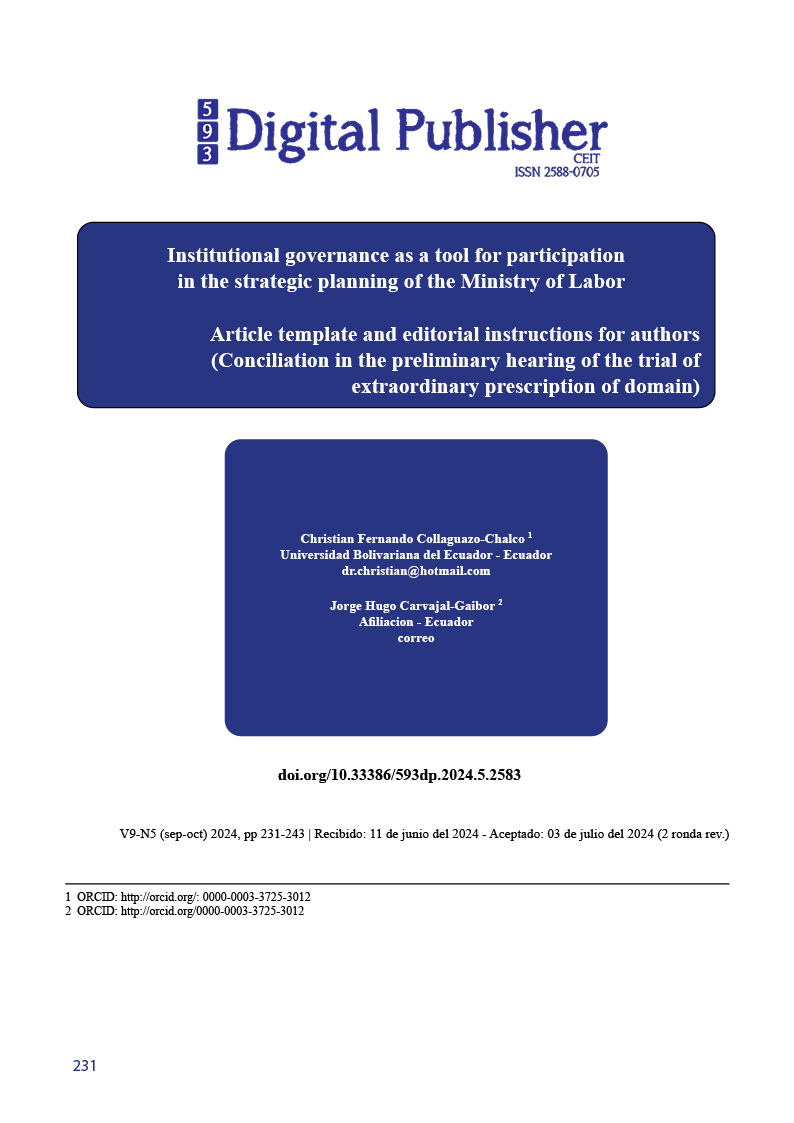Conciliation in the preliminary hearing of the trial of extraordinary prescription of domain
Main Article Content
Abstract
In Ecuador, the extraordinary acquisitive prescription action of domain aims to guarantee the right to property; as observed within our legal system, the same one that establishes the ways of acquiring ownership of a property, regulations that establish that “The ways of acquiring ownership are occupation, accession, tradition, succession due to death, the prescription, and by an enforceable judgment of domain extinction in favor of the State” (Civil Code, 2005, Art. 603).
Therefore, according to article 2392 of the Civil Code (2005), it states that,
“Prescription is a way of acquiring the things of others, or of extinguishing the actions and rights of others, because the things have been possessed, or said actions and rights have not been exercised.”, for a certain time, and the other legal requirements are met” (Art. 2392).
On the other hand, authors such as Rojina (1994) refer to prescription as a method of acquiring properties, currently being a form of acquisition of goods by possession as owner, peaceful, public and continuous, which has occurred for a certain period of time.
For the above reasons, the extraordinary acquisition of ownership prescription is the way to acquire property, through the action contemplated in article 2405 of the Civil
Code, which refers to the topic at hand and;
For this action to operate, it is necessary to be in possession of the thing, for a
certain amount of time and with the spirit of lord and owner, consequently, the owner of the property has stopped exercising his right over that property during the time that the property law allows, and also fails to comply with its obligations regarding the property, granting in a factual manner, to the possessor the exercise of these rights and obligations as if he were the owner, who can obtain ownership by observing the procedure established in the General Organic Code of Process.
Downloads
Article Details

This work is licensed under a Creative Commons Attribution-NonCommercial-ShareAlike 4.0 International License.
1. Derechos de autor
Las obras que se publican en 593 Digital Publisher CEIT están sujetas a los siguientes términos:
1.1. 593 Digital Publisher CEIT, conserva los derechos patrimoniales (copyright) de las obras publicadas, favorece y permite la reutilización de las mismas bajo la licencia Licencia Creative Commons 4.0 de Reconocimiento-NoComercial-CompartirIgual 4.0, por lo cual se pueden copiar, usar, difundir, transmitir y exponer públicamente, siempre que:
1.1.a. Se cite la autoría y fuente original de su publicación (revista, editorial, URL).
1.1.b. No se usen para fines comerciales u onerosos.
1.1.c. Se mencione la existencia y especificaciones de esta licencia de uso.
References
Albán, E. (2011). Manual de Derecho Penal Ecuatoriano. Quito - Ecuador: Ediciones Legales.
Avendaño, J., & Avendaño, F. (2017). Derechos reales (Vol. 1). Fondo Editorial de la PUCP
Cabanellas, G., & y Castillo, L. A.-Z. (1981). Diccionario enciclopédico de derecho usual. Vol. 5. Heliasta. https://dspace.scz.ucb.edu.bo/dspace/ handle/123456789/1246
Cabanellas De Las Cuevas, G. (2008). Diccionario jurídico elemental. Editorial Helíasta SRL.
Castillo, V. El derecho de Propiedad: adquisición, protección y efectos. Recuperado de:
http://ipra-cinder. info/wp content/uploads/2019/03/Victor_Luis_Castillo_Ortega El_Derecho_de_Propiedad. pdf.
Código Civil (2005). Registro Oficial Suplemento 46 de 24-jun.-2005. Obtenido de Última modificación.
Cordero Quinzacara, Eduardo, & Aldunate Lizana, Eduardo. (2008). Evolución histórica del concepto de propiedad. Revista de estudios histórico-jurídicos, (30), 345-385.
https://dx.doi.org/10.4067/S0716-54552008000100013
de Desarrollo Normativo, S. (2015). Código Orgánico General de Procesos (COGEP).
Ecuador. Asamblea Nacional Constituyente. (2008) Constitución de la República del Ecuador. Registro Oficial N. 449. https://www.oas.org/juridico/pdfs/ mesicic4_ecu_const.pdf
Ecuador. Asamblea Nacional. (2015). Código Orgánico General de Procesos. Registro Oficinal Suplemento N. 506. https://www.funcionjudicial.gob.ec/pdf/
CODIGO%20ORGANICO%20GENERAL%20DE%20 PROCESOS.pdf
Echalar Ramirez, G. L. (2017). La importancia de las técnicas de negociación como elemento dentro de la conciliación en la audiencia preliminar del proceso civil
(Master's thesis, Sucre: Universidad Andina Simón Bolívar, Sede Central Sucre).
García Falconí, J. C. (2018). Análisis jurídico del COGEP. Quito: CEP.
Guzmán Barrón, C. (1998). La Conciliación: principales antecedentes y características. Derecho PUCP, 52, 67.
Martínez Montenegro, I. (2023). Sobre los métodos de la investigación jurídica. Revista chilena de derecho y ciencia política, 14.
Masapanta, C. (2022). Multidimensionalidad del Derecho a la Propiedad en el Constitucionalismo Ecuatoriano. JUEES, (2), 74-90.
Menoscal, M., y Vera, A. (2014). “LA CONCILIACION COMO UNA
ALTERNATIVA EN LA SOLUCION DE CONFLICTOS EN EL ECUADOR”
[Tesis de pregrado, Universidad Laica Vicente Rocafuerte de Guayaquil]. http://repositorio.ulvr.edu.ec/bitstream/44000/487/1/T-ULVR-0430.pdf
Morocho, J. (2004), la mediación y la Conciliación en la legislación Civil Ecuatoriana, Editorial edipcentro, Quito- Ecuador
Navarro, A., (2013). “EL OBJETO DE LA PROPIEDAD ESTATAL Y DOMINIO
PÚBLICO DEL ESTADO EN EL DERECHO CUBANO” [Tesis de diplomado, Universidad de Camaguay]
Rojina R. (1994). Compendio de derecho civil II. Teoría general de las obligaciones, Decimonovena ed., Porrúa, México
Sánches, A. (2016). “LA CONCILIACIÒN COMO MECANISMO DE
SOLUCIÓN DE CONFLICTOS, Y LA VOLUNTARIEDAD DE LAS PARTES” [Tesis de pregrado, Universidad Regional Autónoma de los Andes, Uniandes Babahoyo]. https://dspace.uniandes.edu.ec/bitstream/123456789/6078/1/TUBAB071https://dspace.uniandes.edu.ec/bitstream/123456789/6078/1/TUBAB071-2016.pdf2016.pdf
Vallejo, M. G. G., Buste, J. L. R., Oña, L. X. C., & Palacios, J. J. C. (2022). Prescripción extraordinaria adquisitiva de dominio frente al derecho a la propiedad privada de los adultos mayores en el cantón Ambato, Ecuador. Universidad y Sociedad, 14(S4), 576-581.



